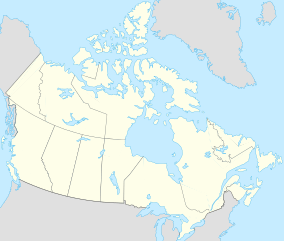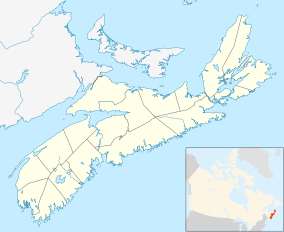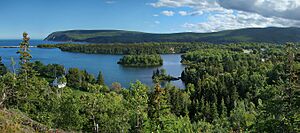Cape Breton Highlands National Park facts for kids
Quick facts for kids Cape Breton Highlands National Park |
|
|---|---|
|
IUCN Category II (National Park)
|
|

Autumn colours in the park
|
|
| Location | Ingonish, Nova Scotia, Canada |
| Area | 949 km2 (366 sq mi) |
| Established | 1936 |
| Visitors | 333,746 (in 2017-18) |
| Governing body | Parks Canada |
| Website | http://www.pc.gc.ca/en/pn-np/ns/cbreton/ |
Cape Breton Highlands National Park is a special place in Nova Scotia, Canada. It's located on the northern part of Cape Breton Island. This park was the very first national park in Canada's Atlantic provinces. It covers a huge area of about 948 square kilometers (366 square miles).
The park is famous for its amazing landscapes. You'll find tall mountains, deep valleys, beautiful waterfalls, and rocky coastlines here. A big part of the park is the Cape Breton Highlands, which is a high, flat area that looks a bit like the tundra. The forests are a mix of Acadian and Boreal trees. The highest point in Nova Scotia, White Hill, is also in the park. It stands at 533.5 meters (1,750 feet) above sea level. Two important rivers, the Chéticamp River and the North Aspy River, flow through the park.
Since 2014, Parks Canada has been working with local groups to help restore the boreal forests in the park. This project helps keep the natural environment healthy.
Contents
Fun Things to Do in the Park
Cape Breton Highlands National Park is a fantastic place for outdoor adventures!
Driving the Cabot Trail
A big part of the famous Cabot Trail scenic highway goes right through the park. This drive offers incredible views of the ocean and mountains. The park is known for its "steep cliffs and deep river canyons that carve into a forested plateau bordering the Atlantic Ocean."
Hiking Trails
There are 26 marked hiking trails for you to explore. One of the most popular is the Skyline Trail. These trails let you see the park's amazing nature up close.
Villages and Beaches
At the western entrance of the park, you'll find the Acadian village of Chéticamp. It's located on the Gulf of Saint Lawrence and has a park information center. On the eastern side of the park, near Ingonish, there are campsites and lovely beaches along the Atlantic Ocean.
Golfing at Highlands Links
If you like golf, the Highlands Links is an 18-hole golf course located in Ingonish at the Keltic Lodge resort. It was designed by Stanley Thompson and is considered one of the best golf courses in the world! It's also certified by a program that helps protect wildlife.
Swimming and Lakes
The park has five main saltwater ocean beaches and two freshwater lakes. The ocean beaches include Ingonish Beach, North Bay Beach, Broad Cove Beach, Black Brook Beach, and La Block Beach. The two freshwater lakes are Freshwater Lake and Warren Lake. During summer, lifeguards watch over Freshwater Lake and Ingonish Beach. Be careful at Black Brook and Ingonish Beach, as they can have strong currents.
Amazing Wildlife
The park is home to many different animals, making it a great place for wildlife spotting!
Birds
You can see many types of birds here, including different kinds of hawks and owls. Look for northern gannets, kestrels, Bicknell's thrush, and the majestic bald eagle. In 2004, the first nests of boreal owls in Nova Scotia were found in this park.
Mammals
The park has many mammals, such as white-tailed deer, marten, lynx, muskrat, snowshoe hare, beaver, mink, bobcat, river otter, stoat, red fox, raccoon, moose, black bear, skunk, and coyote. You might even spot a Gaspé shrew, a small type of long-tailed shrew, on rocky slopes.
In the late 1940s, Parks Canada brought 18 western moose from Elk Island National Park in Alberta to help the moose population grow here.
Marine Life
If you're lucky, you might see amazing sea creatures from the park's coast. These include large North Atlantic right whales, humpback whales, fin whales, minke whales, sei whales, and pilot whales. You might also spot Atlantic white-sided dolphins, harbor seals, harp seals, and grey seals.
Reptiles
The park is also home to several reptiles like the garter snake, red belly snake, ring-necked snake, smooth green snake, wood turtle, and even the large leatherback sea turtle.
The park is recognized as an Important Bird Area because it's so important for many bird species.
Park Geology: A Look at the Rocks
The rocks in Cape Breton Highlands National Park tell an amazing story about Earth's history!
Most of the park sits on a landmass called the Ganderia Terrane. This land was once part of a supercontinent called Gondwana. Over millions of years, it broke away and slowly moved across the ocean. Eventually, it crashed into another landmass called Laurentia. This huge collision, which happened about 400 million years ago, helped form the mountains and landscapes we see today. More collisions with other landmasses like Avalonia and Meguma followed. Then, about 300 million years ago, all the continents came together to form the supercontinent Pangaea. Later, Pangaea began to split apart, creating the Atlantic Ocean we know today.
As you drive along the Cabot Trail, you can see different types of ancient rocks. For example, near Ingonish, you can find 402-million-year-old granodiorite rock. The Keltic Lodge sits on even older rocks, including 493-million-year-old granite.
The beach in front of Freshwater Lake is a classic "shingle beach." It's a barrier beach made of smooth, rounded boulders that have been polished by ocean waves. You can also see signs of glaciers, like glacial debris, near the lake.
Further along the Cabot Trail, you'll see different types of granite and orthogneiss rocks. Near Cape North, the trail follows the Aspy Fault, a large crack in the Earth's crust. Here, you can find younger rocks from the Carboniferous period, including limestone, mudstone, and sandstone. These rocks were formed from sediments deposited by rivers and in ancient seas.
The park's geology is a fascinating look into how continents move and how mountains and landscapes are shaped over millions of years.
Images for kids
-
Long-finned pilot whales spyhopping off Cape Breton
See also
 In Spanish: Parque nacional Cape Breton Highlands para niños
In Spanish: Parque nacional Cape Breton Highlands para niños










